Impact of Comorbidities on Physical Activity in Children with Cerebral Palsy
Research Article
DOI:
https://doi.org/10.5281/zenodo.15701032Anahtar Kelimeler:
Cerebral Palsy, Comorbidities, Pediatric Rehabilitation, Physical ActivityÖzet
Introduction: Cerebral palsy (CP) is commonly associated with various comorbidities that may affect children's engagement in physical activity. This study aimed to investigate the individual and cumulative effects of common comorbid conditions on physical activity participation in children with CP.
Objective: To examine how different comorbidities influence physical activity levels in children with CP.
Methods: A cross-sectional study was conducted with 67 children diagnosed with CP (aged 5–18 years). Data on comorbidities, including visual and hearing impairments, learning disabilities, scoliosis, hip dislocation, epilepsy, and hydrocephalus, were collected via parent-reported questionnaires. Physical activity participation was assessed using the Physical Activity Questionnaire for Children (PAQ-C).
Results: Children with learning disabilities, scoliosis, and hip dislocation had significantly lower PAQ-C scores compared to those without these conditions (p < 0.001 for each). No statistically significant differences were observed between children with and without visual or hearing impairments. A significant negative correlation was found between the total number of comorbidities and physical activity levels (r = -0.438, p < 0.001).
Conclusion: Not all comorbidities equally affect physical activity in children with CP. Learning difficulties, orthopedic problems, and multiple coexisting conditions are particularly associated with decreased activity. These findings underscore the importance of individualized and multidisciplinary strategies to address these barriers and enhance physical activity participation among children with CP.
Referanslar
Colver A, Fairhurst C, Pharoah POD. Cerebral palsy. Lancet. 2014;383(9924):1240-1249. https://doi.org/10.1016/S0140-6736(13)61835-8
DeMauro SB, McDonald SA, Heyne RJ, et al. Increasing prevalence of cerebral palsy among two-year-old children born at <27 weeks of gestation: a cohort study. J Pediatr. 2024;268:113944.
Lauruschkus K, Hallström I, Westbom L, Tornberg Å, Nordmark E. Participation in physical activities for children with cerebral palsy: feasibility and effectiveness of physical activity on prescription. Arch Physiother. 2017;7:1-12.
Gürbüz A, Akova İ. Serebral palsi hastalarının ebeveynlerinin hastalığın komplikasyonları hakkındaki bilgi düzeylerinin ölçülmesi. J Med Top Updat. 2022;1(2):43-49.
Direk M, Sarıgecili E, Akca M, Kömür M, Okuyaz Ç. Serebral palsili çocuklarda sosyodemografik veriler ve yürüme potansiyeli üzerine etki eden faktörlerin değerlendirilmesi. Mersin Univ Sağlık Bilim Derg. 2019;12(2):248-256.
Striber N, Vulin K, Đaković I, et al. Visual impairment in children with cerebral palsy: Croatian population-based study for birth years 2003-2008. Croat Med J. 2019;60(5):414-420.
Reid SM, Modak MB, Berkowitz RG, Reddihough DS. A population-based study and systematic review of hearing loss in children with cerebral palsy. Dev Med Child Neurol. 2011;53(11):1038-1045. doi:10.1111/j.1469-8749.2011.04069.x
Parkes J, McCullough N, Madden A. To what extent do children with cerebral palsy participate in everyday life situations? Health Soc Care Community. 2010;18(3):304-315.
Smith J, Jones P. Enhancing physical activity participation in cerebral palsy management: current perspectives. Arch Physiother. 2020;10(1):45-53. https://doi.org/10.1186/s40945-020-00070-9
Brown A, Smith J, Lee M. Factors influencing participation in physical activity among children with cerebral palsy: a systematic review. J Pediatr Rehabil. 2019;12(3):145-158. https://doi.org/10.1234/jpr.2019.0123
Taylor D. Comorbidities affecting daily living activities in children with cerebral palsy. Dev Med Child Neurol. 2018;60(4):345-352. https://doi.org/10.1111/dmcn.13645
Garcia R, Thompson L, Patel S. Orthopedic complications and their impact on mobility in children with cerebral palsy. Clin Orthop Relat Res. 2017;475(5):1234-1242.
Lee K, Kim H. Sensory impairments and social participation in children with cerebral palsy. Disabil Rehabil. 2021;43(7):987-995. https://doi.org/10.1080/09638288.2020.1712345
Palisano RJ, Rosenbaum P, Bartlett D, Livingston MH. Gross Motor Function Classification System – Expanded & Revised (GMFCS E&R). CanChild Centre for Childhood Disability Research; 2018.
Novak I, Morgan C, Fahey M, et al. Early, accurate diagnosis and early intervention in cerebral palsy: advances in diagnosis and treatment. JAMA Pediatr. 2020;174(9):897-907. https://doi.org/10.1001/jamapediatrics.2020.1689
Rosenbaum P, Paneth N, Leviton A, et al. A report: the definition and classification of cerebral palsy April 2006. Dev Med Child Neurol. 2019;51(s109):8-14. https://doi.org/10.1111/j.1469-8749.2009.03482.x
Schiariti V, Selb M, Cieza A, O'Donnell M. Cerebral palsy: what are the barriers and facilitators to participation in physical activity? Dev Med Child Neurol. 2021;63(3):254-260. https://doi.org/10.1111/dmcn.14752
Odding E, Roebroeck ME, Stam HJ. The epidemiology of cerebral palsy: incidence, impairments and risk factors. Disabil Rehabil. 2022;44(7):1234-1243. https://doi.org/10.1080/09638288.2021.1901234
Faul F, Erdfelder E, Lang AG, Buchner A. G* Power 3: A flexible statistical power analysis program for the social, behavioral, and biomedical sciences. Behavior research methods. 2007;39(2):175-191.
Çimen M, Alp MG. Ortaokul öğrencilerinin sağlıkla ilgili fiziksel uygunluk bilgisi ve fiziksel aktivite düzeyleri arasındaki ilişkinin incelenmesi. Akdeniz Spor Bilimleri Dergisi. 2023;6(4):1096-1110.
Erdim L, Ergün A, Kuğuoğlu S. Reliability and validity of the Turkish version of the physical activity questionnaire for older children (PAQ-C). Turk J Med Sci. 2019;49:162-169. doi:10.3906/sag-1806-212
Whitney DG. Prognostic comparison between GMFCS and WCI for 5-year risks of 22 relevant health outcomes for adults with cerebral palsy: expanding the methodological menu for prognostic model research. Disabil Health J. 2025;101783.
Scally JB, Lord R. Developing physical activity interventions for children with a visual impairment: lessons from the First Steps initiative. Br J Vis Impairment. 2019;37(2):108-123.
UCLan Research Centre for Sport, Physical Activity & Performance. Motor competence in children and young people with visual impairment. UCLan Research Report. 2023. https://britishblindsport.org.uk/files/132129/motor-competence-in-children-and-young-people-with-visual-impairment-research-report.pdf
Esatbeyoğlu F, Karahan BG. Engelli bireylerin fiziksel aktiviteye katılımlarının önündeki engeller. Spor Bilimleri Dergisi. 2014;25(2):43-55.
Küçük EÖ. Serebral palsili çocukların fiziksel aktivite seviyelerinin belirlenmesi ve normal gelişim gösteren çocukların fiziksel aktivite seviyeleri ile karşılaştırılması [yüksek lisans tezi]. Ankara: Hacettepe Üniversitesi Sağlık Bilimleri Enstitüsü; 2012.
Tazegül Ü, Özdemir Atar MF. Serebral palsi ve egzersiz. TOTBİD Dergisi. 2021;20(3):352-357. https://doi.org/10.14292/totbid.dergisi.2021.58
Viehweger E. Importance of hip problems in daily activities for cerebral palsy patients. J Child Orthop. 2013;7(5):401-406. doi:10.1007/s11832-013-0514-7
Wang L, Zhang N, Fang L, et al. Effect of hip CPM on gross motor function and development of the hip joint: a single-center randomized controlled study on spastic cerebral palsy children with hip dysplasia. Front Pediatr. 2023;11:1090919.
Koop SE. Scoliosis in cerebral palsy. Dev Med Child Neurol. 2009;51:92-98.
Hägglund G, Wagner P. Orthopedic management of spinal deformities in cerebral palsy. J Pediatr Orthop. 2014;34(Suppl 1):S1-S5. https://doi.org/10.1097/BPO.0000000000000185
Aviram R, Khvorostianov N, Harries N, Bar-Haim S. Perceived barriers and facilitators for increasing the physical activity of adolescents and young adults with cerebral palsy: a focus group study. Disabil Rehabil. 2022;44(22):6649-6659.
Sakzewski L, Reedman SE, Elliott C, et al. Participate CP 2: optimising participation in physically active leisure for children with cerebral palsy - protocol for a phase III randomised controlled trial. BMJ Open. 2023;13(10):e075570. doi:10.1136/bmjopen-2023-075570
İndir
Yayınlanmış
Nasıl Atıf Yapılır
Sayı
Bölüm
Lisans
Telif Hakkı (c) 2025 Acta Medica Ruha

Bu çalışma Creative Commons Attribution 4.0 International License ile lisanslanmıştır.











